UK Royal Mail has reacted to the RailFreight.com revelations that it is scrapping its fleet of dedicated mail trains. The UK postal service, which has used the railways as a prime mover for almost two centuries, says it will still transport mail by rail, maintaining the concept of the mail train. However, that is despite informing its rail freight partner, DB Cargo UK, that it was abandoning its operations and maintenance contract in a few months.
Royal Mail has blamed the age of its dedicated train fleet as the reason for abandoning its own branded mail trains. The fleet of express electric multiple units, built by British Rail Engineering Limited (BREL) and designated Class 325, are now almost thirty years old. Royal Mail says it will turn to other operators to fulfil its needs. It does however admit it will be recruiting extra truck drivers to cover day-to-day operations.
Using commercial rail services in future
Undisclosed commercial rail freight operators will take up the loss of Royal Mail trains, says the British postal service. “We’ll be continuing to use rail services,” said a statement from the Royal Mail. They say that the story carried across the UK media, including by RailFreight.com, concerns their own fleet of branded mail trains. “Our freight trains are at the end of their operational lives,” said Royal Mail. “Going forward, we’ll use a combination of commercial rail services, our existing road network and reduced domestic air services to transport the mail held by our freight services.”
At present, there are thirteen scheduled mail trains each week in the UK, mostly running via the busy West Coast Main Line. The claim that Royal Mail may find alternative rail transport has raised speculation of mail bags being loaded into locked-off passenger carriages, or travelling as container loads on intermodal services. Express logistics operators, such as InterCity RailFreight or Varamis Rail, are already building a market, moving small packets by rail.
Sensible to take distribution in-house
A briefing seen by Kevin Swallow, the editor of Transport News in the UK, says that the Royal Mail will take much of the additional road driving in-house. “Royal Mail has told me that across the UK, the additional driving workload will create more than 30 full-time driving jobs,” he said. “If the Royal Mail is winding down its rail operations, as indeed they have with their domestic air mail handling, then it makes some sense for the company to have their distribution handled in-house.”

If the maintenance of their rail fleet is proving problematic, then it would only echo the situation with road vehicles. “The older the vehicle, the more difficult it is to procure parts,” explained Kevin Swallow. “I can appreciate the ire of DB Cargo UK, since they have the maintenance contract. However, it’s not necessarily a question of maintenance expertise. Keeping older vehicles operational depends greatly on the availability of replacement parts.”
Train paths proving difficult to come by
The fleet of Class 325 electric multiple units, built by BREL in the mid 1990s, were based on contemporary passenger designs. 16 four-car sets were built, of which fifteen remain in service. Royal Mail operates them in multiple formations. “Our six trains are almost 30 years old, around twice the industry average of 16 years,” said Royal Mail, presumably with reference to the overall fleet age on the UK network, which includes the passenger fleet. Royal Mail also says it is proving difficult to secure paths for running its trains. It does not go into detail, but the problems of finding paths on the busy West Coast Main Line are well documented.
“Royal Mail will continue to use rail services to transport mail across the country,” said a Royal Mail spokesperson. “However our own freight trains are at the end of their operational lives. The trains are almost 30 years old and it is increasingly difficult to secure parts for maintenance and the routes we need to meet our service requirements. To improve reliability, increase cost effectiveness and remain consistent with our environmental goals, over the coming months we will cease operating our own trains whilst continuing to use a mix of rail, road and air to transport mail to all corners of the UK.”
The Royal Mail was privatised in 2013. It has had a difficult time in a changing market. The mail service has recently changed hands once again. Its current owner, International Distribution Services, has sold the company to Czech investor Daniel Kretinsky for £3.5 billion (around €4 billion).